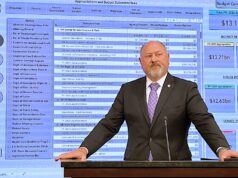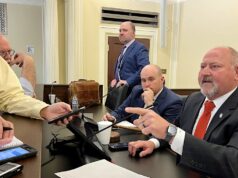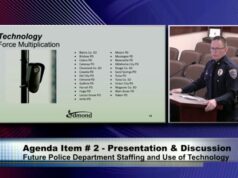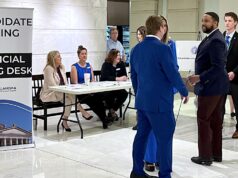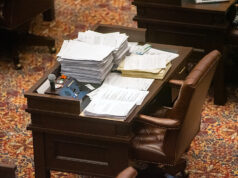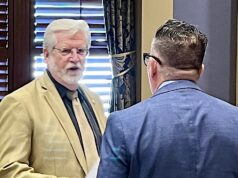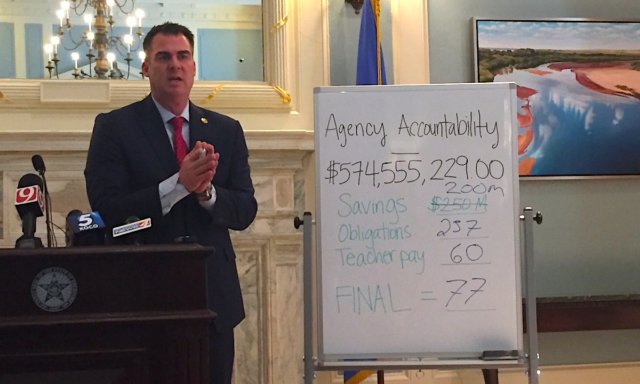

The Oklahoma Legislature will have $574.5 million more to appropriate for the state’s next fiscal year after the Board of Equalization certified an official estimate this morning.
After the meeting, however, Gov. Kevin Stitt told media that $237 million of that revenue must be dedicated to existing financial obligations, and he called for an additional $200 million in savings and $60 million to be dedicated to a $1,200-per-teacher pay raise.
“These estimates are very encouraging to me,” Stitt said before putting marker to white board to explain his fiscal preferences. “Since we lowered our revenue projections a little bit, we are going to say our savings goal is $1 billion.”
With the Board of Equalization hearing that the state’s Rainy Day Fund is estimated to reach $811.3 million, reaching $1 billion in savings would require the Legislature to hold back at least $189 million from next year’s budget.
“We’ve got to have agency accountability,” Stitt emphasized.
Board of Equalization presentation
Total estimates fell about $37.8 million from the board’s December meeting. Since then, the estimate for gross production taxes on natural gas dropped about $53.2 million, and the estimate on personal income taxes also dropped about $27.9 million.
“In Oklahoma, it has become painfully clear that gross production taxes remain a highly volatile revenue source in our budget,” said Shelly Paulk, deputy budget director for the Office of Management and Enterprise Services (OMES).
The estimate on use taxes rose by about $48.1 million, and the estimate on sales taxes increased by about $23.2 million. OMES provided the following overview of the estimate:

The OMES sheet noted that total funds available for expenditure in FY 2020 will be $8.2 billion. Almost $360 million is projected to be deposited into the state’s constitutionally-stipulated Rainy Day Fund, putting its balance at $811.3 million, according to the OMES handout.
“There was a lot of concern that we would lose a lot more for this upcoming fiscal year, so this is really good news,” Paulk said.
The full Board of Equalization FY 2020 revenue certification packet is embedded here:
 Loading...
Loading...
House Speaker Charles McCall (R-Atoka) released a statement about the Board of Equalization numbers Wednesday around 2 p.m.
“It is encouraging to have surplus revenue available to help meet the needs of our core state agencies, especially after many years of budget deficits,” McCall said.
The House press release included remarks from Appropriations and Budget Chairman Kevin Wallace (R-Wellston).
“We are in a much better position than we have been in recently, but we have to be realistic about how far this surplus can go,” Wallace said. “The reality is that approximately $200 million of that surplus has already been spent in teacher flex benefit increases, ad valorem reimbursements, bond payments and the Children’s Health Insurance Program.”
Wallace said the $1,200 teacher pay raise House leaders and Stitt are seeking would cost $70 million, and his statement underscored the Legislature’s difference in position on the additionals savings Stitt advocated for earlier in the day.
“If the Legislature passes the $1,200 teacher pay raise, which would cost $70 million, and the $30 million appropriation to the County Roads and Bridges Fund, that will be another $100 million,” Wallace said. “Frankly, given our recent history, I think it would be prudent to set aside at least 10 percent of that surplus to begin building a state savings account. The rest will be available to help invest in our state agencies, which have already sent us budget increase requests topping $1.2 billion over last year and more than $33 million in supplemental funding requests.”
Background on the Board of Equalization

Members of the Board of Equalization include: Stitt, Lt. Gov. Matt Pinnell, Attorney General Mike Hunter, State Treasurer Randy McDaniel, State Auditor and Inspector Cindy Byrd, Superintendent of Public Instruction Joy Hofmeister and Secretary of Agriculture Blayne Arthur. The board meets three times annually, in June, December and February.
In December, the board estimated that the Legislature could have $612 million more to appropriate than the year before. But Stitt and legislative leaders have consistently said much of that money will already be spoken for.
In his Feb. 4 State of the State address, Stitt called for a $1,200 teacher pay raise, a series of other limited investments and broad austerity with remaining state revenue, which he said should be dedicated toward ensuring that Oklahoma consistently has enough cash on hand to cover three months worth of operations during economic downturns.
(Correction: This story was updated at 11:27 a.m. Wednesday, Feb. 20, to spell Shelly Paulk’s name correctly. NonDoc regrets the typo. The story was also updated at 2:40 p.m. to include comments from McCall and Wallace.)









